Spray Characterization of Direct Hydrogen Injection as a Green Fuel with Lower Emissions
Abstract
1. Introduction
2. Tools and Methodology
2.1. Experimental Facilities
2.2. Test Matrix
2.3. Methodology
2.3.1. Single-Pass Schlieren Imaging
2.3.2. Image Processing
2.3.3. Contour Analysis
2.3.4. Injection Rate Analysis
3. Results and Discussion
3.1. Effects of Injection Pressure
3.2. Effects of Chamber Temperature
3.3. Effects of Injection Timing
3.4. Mass Flow Rate Measurement
4. Conclusions
- As observed in other recent studies regarding the influence of the pressure ratio on jet spray penetration and cross-sectional area, this research replicated the results, showing that an increase in the pressure ratio leads to greater spray penetration and a larger cross-sectional area of the jet. Regarding the temperature variation, it did not appear to affect jet penetration.
- With regard to the relationship between the injected volume and temperature, our study of temperature alone did not appear to be decisive, as there was no discernible relationship between the increase in temperature and the reduction in the density corresponding to a larger injected volume. While it cannot be guaranteed, one hypothesis is that this could be due to the optical configuration of the images obtained through the Schlieren technique, based on the premise that higher temperatures in the chamber result in a decreased density gradient, potentially leading to a reduced detection of the jet contour in the later stages of processed image with a fixed threshold for every temperature operating point. This phenomenon would be interesting to study in more depth with a different injector, which would allow for a wider range of applicable temperatures; thus, an experimental campaign should be conducted with iso-settings over a broad temperature range.
- Regarding the effect of the injection energizing time on jet penetration, in this study, no discernible influence was observed for the three different injection timings used (2500, 5000, 7000 µs).
- The results obtained for the ROI corroborated those of the analysis of Schlieren image processing regarding the increased volume obtained with a higher pressure ratio, leading to a greater injected mass. This finding aligns with observations from other studies within the same research context.
Author Contributions
Funding
Data Availability Statement
Acknowledgments
Conflicts of Interest
Nomenclature
| ICE | Internal combustion engine |
| FC | Fuel cell |
| HPHT | High-pressure high-temperature |
| ECN | Engine combustion network |
| ROI | Rate of Injection |
| Tch | Chamber temperature |
| Pinj | Injection pressure |
| Pch | Chamber pressure, also mentioned as BP (backpressure) |
| Tinj | Injector energizing time |
| aSOE | After start of energizing |
| ∆P | Pressure difference between chamber pressure and injection pressure |
| ρ | Density |
| CFD | Computational fluid dynamics |
| CO2 | Carbon dioxide |
| H2 | Hydrogen |
References
- Yip, H.L.; Srna, A.; Yuen, A.C.Y.; Kook, S.; Taylor, R.A.; Yeoh, G.H.; Medwell, P.R.; Chan, Q.N. A Review of Hydrogen Direct Injection for Internal Combustion Engines: Towards Carbon-Free Combustion. Appl. Sci. 2019, 9, 4842. [Google Scholar] [CrossRef]
- Verhelst, S. Recent progress in the use of hydrogen as a fuel for internal combustion engines. Int. J. Hydrogen Energy 2014, 39, 1071–1085. [Google Scholar] [CrossRef]
- Martins, J.; Brito, F.P. Alternative Fuels for Internal Combustion Engines. Energies 2020, 13, 4086. [Google Scholar] [CrossRef]
- European Commission. Technical Studies for the Development of Euro 7-ET0922457ENN; European Commission: Brussels, Belgium, 2022. [Google Scholar] [CrossRef]
- European Commission. Technical Studies for the Development of Euro 7-ET0522275ENN; European Commission: Brussels, Belgium, 2022. [Google Scholar] [CrossRef]
- Trombley, G.; Toulson, E. A fuel-focused review of pre-chamber initiated combustion. Energy Convers. Manag. 2023, 298, 117765. [Google Scholar] [CrossRef]
- Zhou, A.; Li, X.-S.; Ren, X.-D.; Li, X.; Gu, C.-W. Evaluation of the performance and economy for a hybrid energy storage system using hydrogen and compressed carbon dioxide as the energy carrier. Energy Convers. Manag. 2022, 264, 115700. [Google Scholar] [CrossRef]
- Batra, P. Alternative Energy Technologies: The Unconventional Dependable; SAE Technical Papers; SAE International: Warrendale, PA, USA, 2015; Volume 2015. [Google Scholar] [CrossRef]
- Yan, F.; Xu, L.; Wang, Y. Application of hydrogen enriched natural gas in spark ignition IC engines: From fundamental fuel properties to engine performances and emissions. Renew. Sustain. Energy Rev. 2018, 82, 1457–1488. [Google Scholar] [CrossRef]
- Sun, X.; Liu, H.; Duan, X.; Guo, H.; Li, Y.; Qiao, J.; Liu, Q.; Liu, J. Effect of hydrogen enrichment on the flame propagation, emissions formation and energy balance of the natural gas spark ignition engine. Fuel 2022, 307, 121843. [Google Scholar] [CrossRef]
- Rueda-Vázquez, J.M.; Serrano, J.; Pinzi, S.; Jiménez-Espadafor, F.J.; Dorado, M.P. A Review of the Use of Hydrogen in Compression Ignition Engines with Dual-Fuel Technology and Techniques for Reducing NOx Emissions. Sustainability 2024, 16, 3462. [Google Scholar] [CrossRef]
- Rahman, M.M.; Mohammed, M.K.; Bakar, R.A. Effects of Air Fuel Ratio on the Performance of Hydrogen Fuel Port Injection Engine. Available online: https://www.researchgate.net/publication/261170801_Effects_of_Air_Fuel_Ratio_on_the_Performance_of_Hydrogen_Fuel_Port_Injection_Engine#:~:text=It%20is%20shown%20that%20decreases,speed%20and%20air%2Dfuel%20ratio (accessed on 12 February 2024).
- Antunes, J.G.; Mikalsen, R.; Roskilly, A. An experimental study of a direct injection compression ignition hydrogen engine. Int. J. Hydrogen Energy 2009, 34, 6516–6522. [Google Scholar] [CrossRef]
- Naganuma, K.; Honda, T.; Yamane, K.; Takagi, Y.; Kawamura, A.; Yanai, T.; Sato, Y. Efficiency and Emissions-Optimized Operating Strategy of a High-pressure Direct Injection Hydrogen Engine for Heavy-duty Trucks. SAE Int. J. Engines 2010, 2, 132–140. [Google Scholar] [CrossRef]
- Tsujimura, T.; Suzuki, Y. Development of a large-sized direct injection hydrogen engine for a stationary power generator. Int. J. Hydrogen Energy 2019, 44, 11355–11369. [Google Scholar] [CrossRef]
- Takagi, Y.; Oikawa, M.; Sato, R.; Kojiya, Y.; Mihara, Y. Near-zero emissions with high thermal efficiency realized by optimizing jet plume location relative to combustion chamber wall, jet geometry and injection timing in a direct-injection hydrogen engine. Int. J. Hydrogen Energy 2019, 44, 9456–9465. [Google Scholar] [CrossRef]
- Wimmer, A.; Wallner, T.; Ringler, J.; Gerbig, F. H2-Direct Injection—A Highly Promising Combustion Concept; SAE International: Warrendale, PA, USA, 2005. [Google Scholar]
- Wallner, T.; Lohsebusch, H.; Gurski, S.; Duoba, M.; Thiel, W.; Martin, D.; Korn, T. Fuel economy and emissions evaluation of BMW Hydrogen 7 Mono-Fuel demonstration vehicles. Int. J. Hydrogen Energy 2008, 33, 7607–7618. [Google Scholar] [CrossRef]
- Luo, Q.-H.; Sun, B.-G. Inducing factors and frequency of combustion knock in hydrogen internal combustion engines. Int. J. Hydrogen Energy 2016, 41, 16296–16305. [Google Scholar] [CrossRef]
- Lee, S.; Hwang, J.; Bae, C. Understanding hydrogen jet dynamics for direct injection hydrogen engines. Int. J. Engine Res. 2023, 24, 4433–4444. [Google Scholar] [CrossRef]
- Yeganeh, M.; Cheng, Q.; Dharamsi, A.; Karimkashi, S.; Kuusela-Opas, J.; Kaario, O.; Larmi, M. Visualization and comparison of methane and hydrogen jet dynamics using schlieren imaging. Fuel 2023, 331, 125762. [Google Scholar] [CrossRef]
- Bower, G.R.; Foster, D.E. A Comparison of the Bosch and Zuech Rate of Injection Meters; SAE International: Warrendale, PA, USA, 1991. [Google Scholar]
- Cavicchi, A.; Postrioti, L.; Berni, F.; Fontanesi, S.; Di Gioia, R. Evaluation of hole-specific injection rate based on momentum flux measurement in GDI systems. Fuel 2020, 263, 116657. [Google Scholar] [CrossRef]
- Gimeno, J.; Martí-Aldaraví, P.; Carreres, M.; Peraza, J.E. Effect of the nozzle holder on injected fuel temperature for experimental test rigs and its influence on diesel sprays. Int. J. Engine Res. 2018, 19, 374–389. [Google Scholar] [CrossRef]
- Gimeno, J.; Bracho, G.; Martí-Aldaraví, P.; Peraza, J.E. Experimental study of the injection conditions influence over n-dodecane and diesel sprays with two ECN single-hole nozzles. Part I: Inert atmosphere. Energy Convers. Manag. 2016, 126, 1146–1156. [Google Scholar] [CrossRef]
- Peraza, J.E.; Payri, R.; Gimeno, J.; Carvallo, C. Analysis of spray/wall impingement using an ECN single-hole injector and a controlled-temperature wall under realistic engine conditions. Appl. Therm. Eng. 2022, 208, 118167. [Google Scholar] [CrossRef]
- Payri, R.; Gimeno, J.; Peraza, J.E.; Bazyn, T. Spray/wall interaction analysis on an ECN single-hole injector at diesel-like conditions through Schlieren visualization. In Proceedings of the ILASS-Europe 2017, Valencia, Spain, 6–8 September 2017. [Google Scholar]
- Naber, J.D.; Siebers, D.L. Effects of Gas Density and Vaporization on Penetration and Dispersion of Diesel Sprays. J. Engines 1996, 105, 82–111. [Google Scholar]
- Payri, R.; Gimeno, J.; Mata, C.; Viera, A. Rate of injection measurements of a direct-acting piezoelectric injector for different operating temperatures. Energy Convers. Manag. 2018, 154, 387–393. [Google Scholar] [CrossRef]
- Payri, R.; Bracho, G.; Marti-Aldaravi, P.; Viera, A. Near field visualization of diesel spray for different nozzle inclination angles in non-vaporizing conditions. At. Sprays 2017, 27, 251–267. [Google Scholar] [CrossRef]
- Yeganeh, M.; Akram, M.S.; Cheng, Q.; Karimkashi, S.; Kaario, O.; Larmi, M. Experimental study of hydrogen jet dynamics: Investigating free momentum and impingement phenomena. Int. J. Hydrogen Energy 2024, 68, 1423–1437. [Google Scholar] [CrossRef]
- Lazzaro, M. High-Speed Imaging of a Vaporizing GDI Spray: A Comparison between Schlieren, Shadowgraph, DBI and Scattering; SAE Technical Papers; SAE International: Warrendale, PA, USA, 2020; Volume 2020. [Google Scholar] [CrossRef]
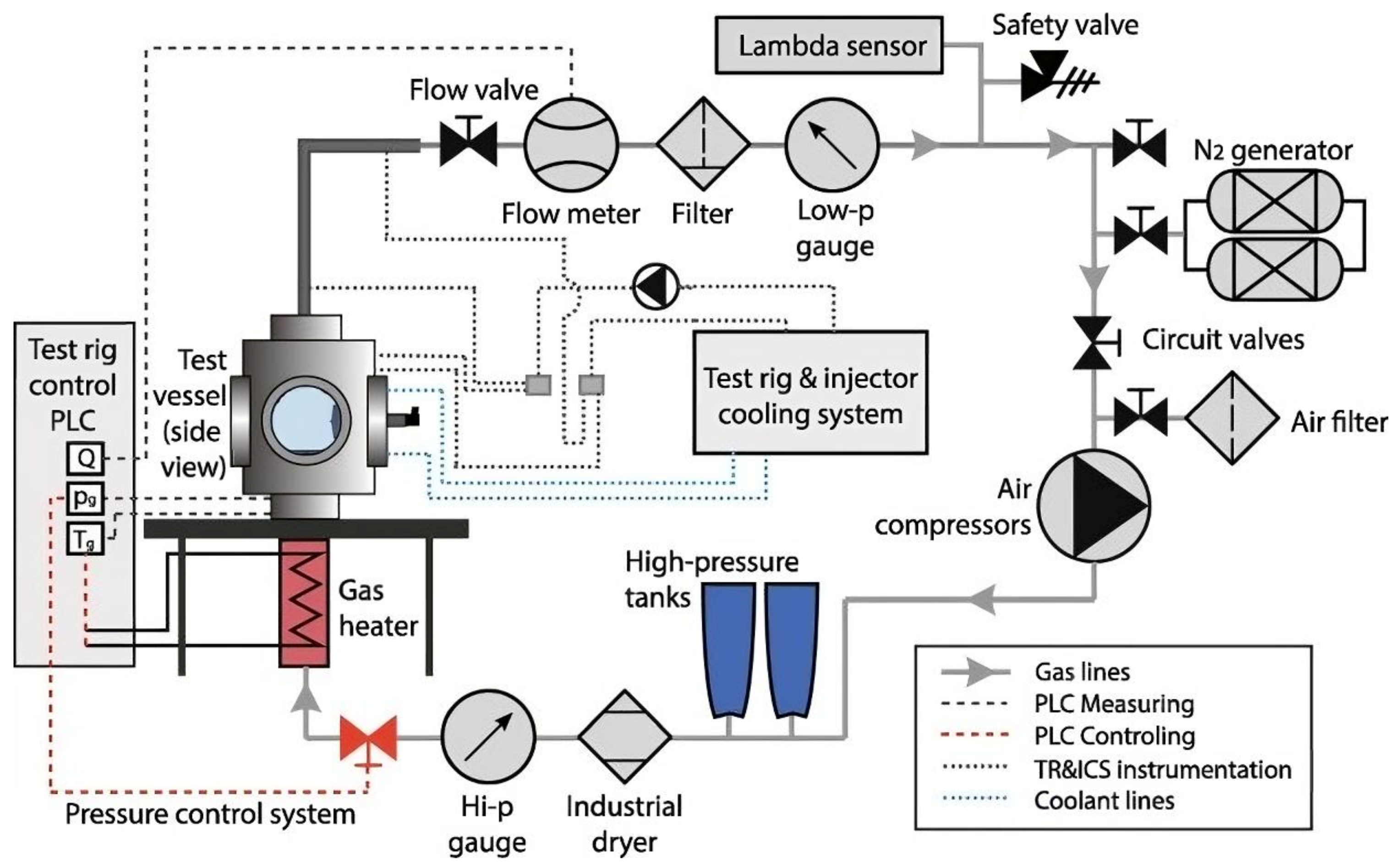
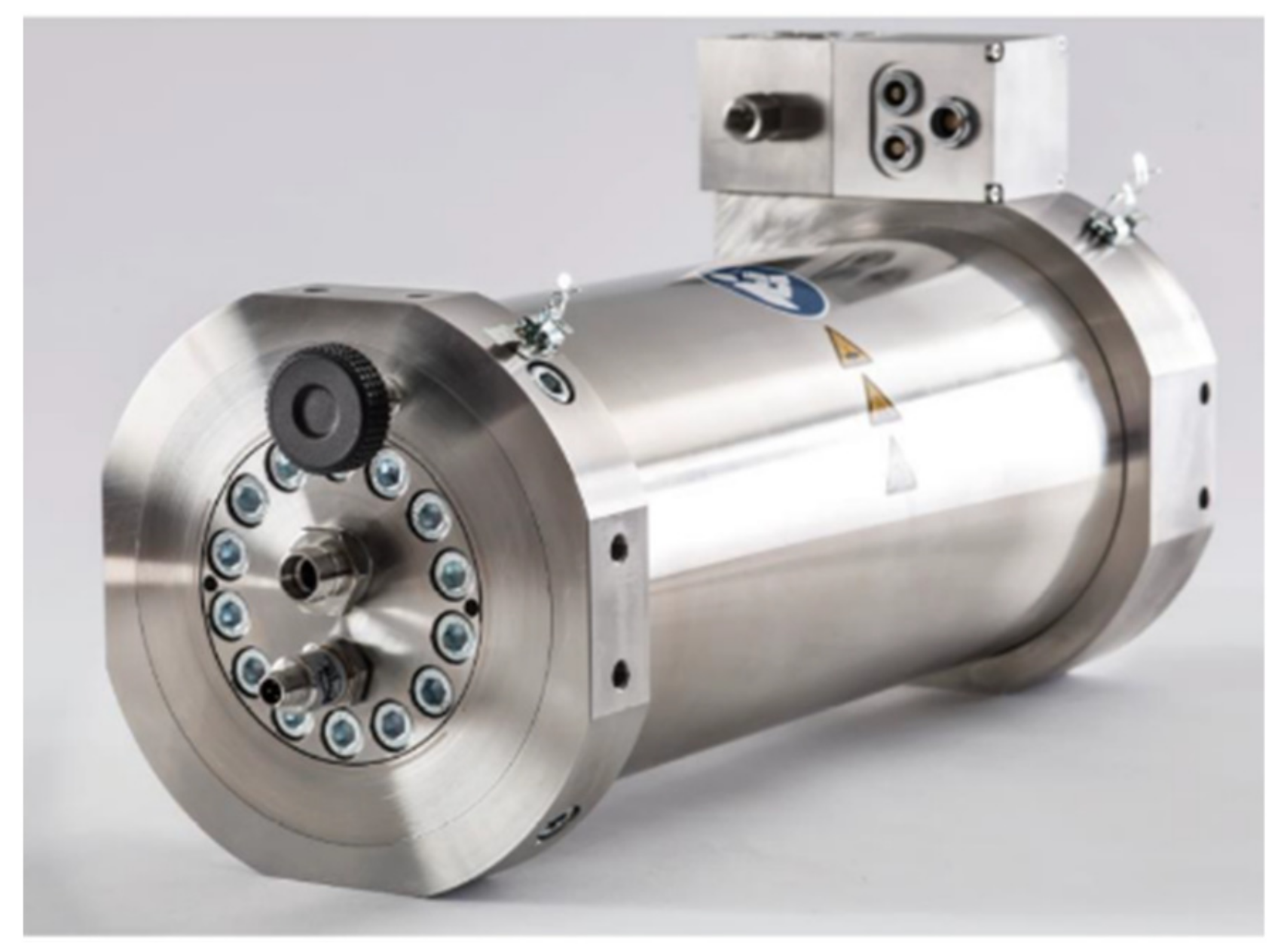
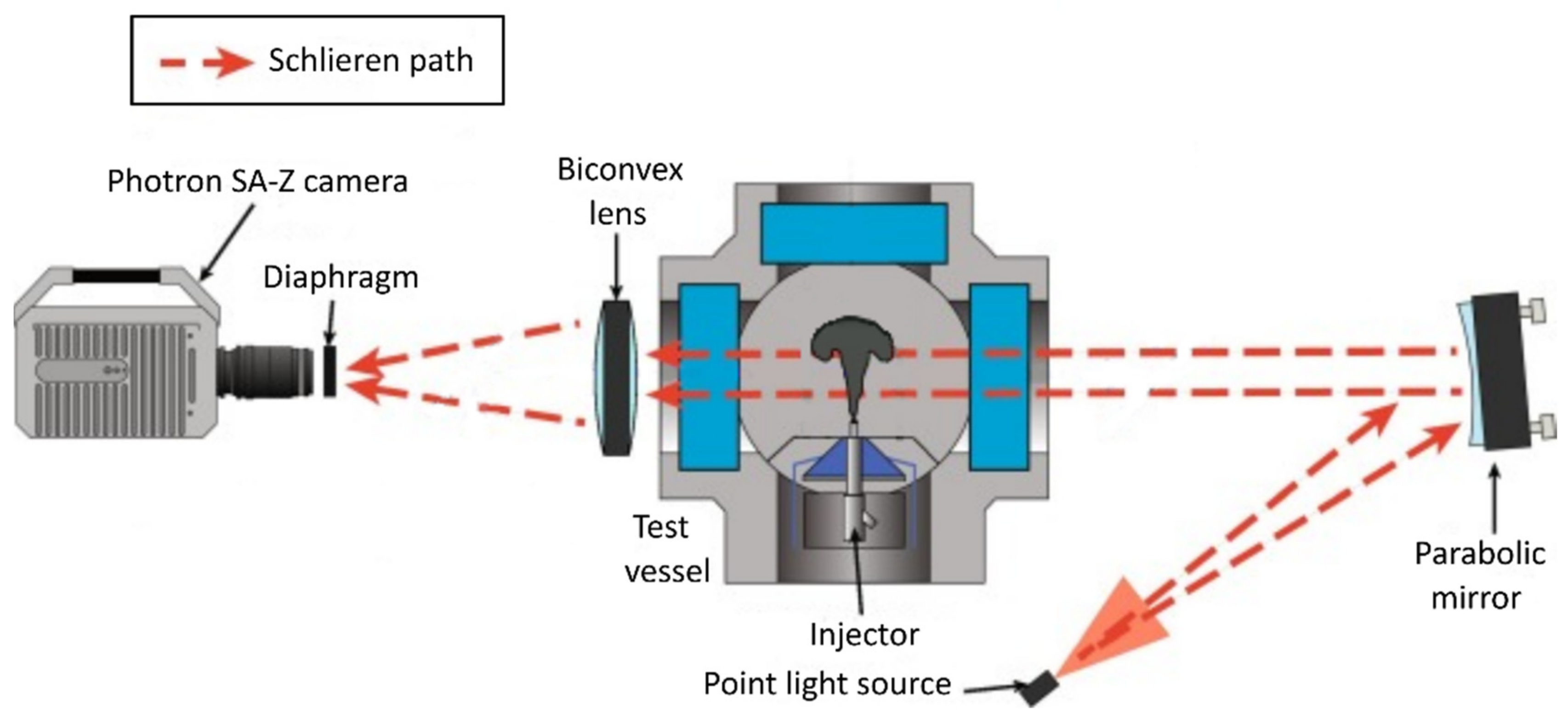

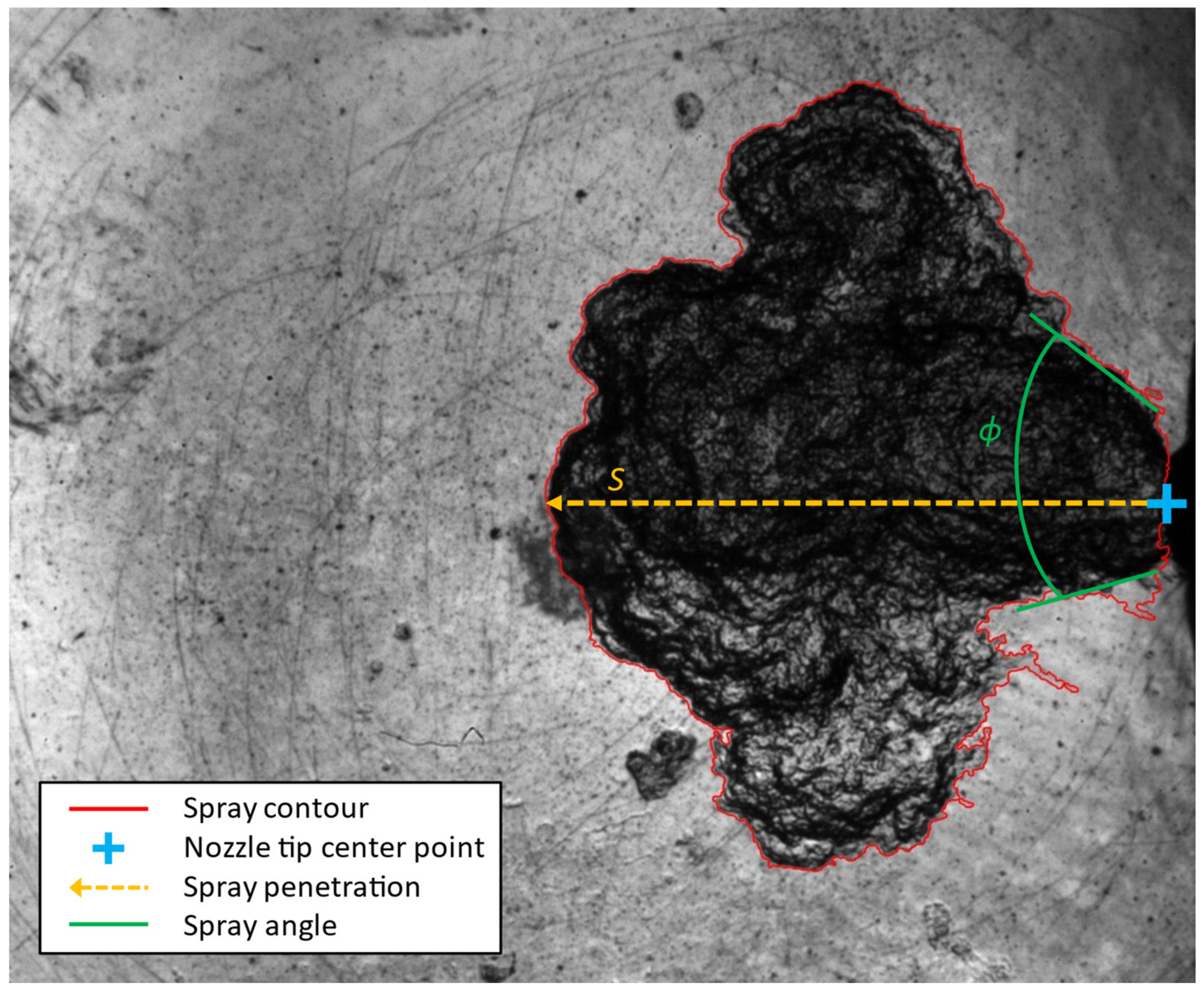
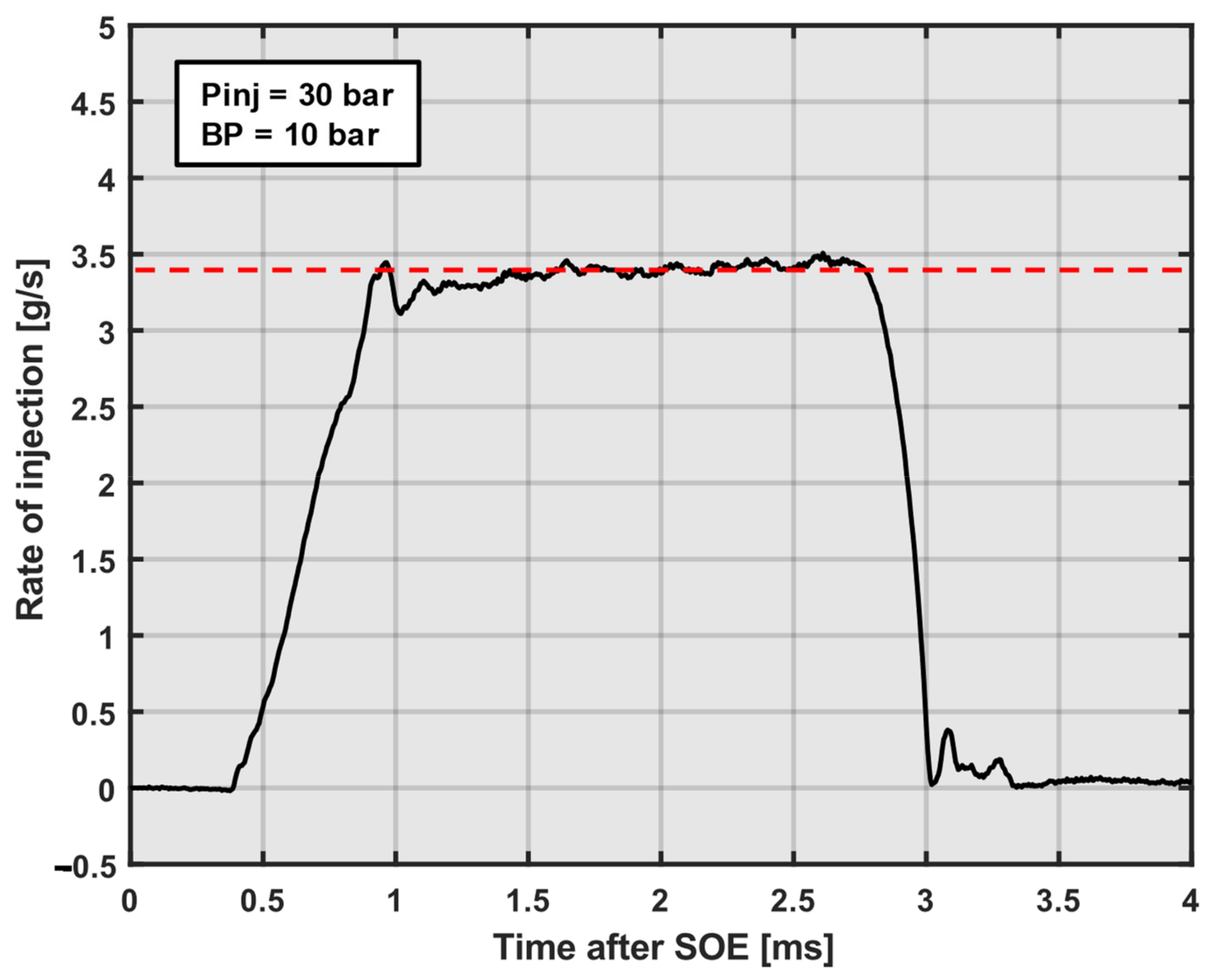
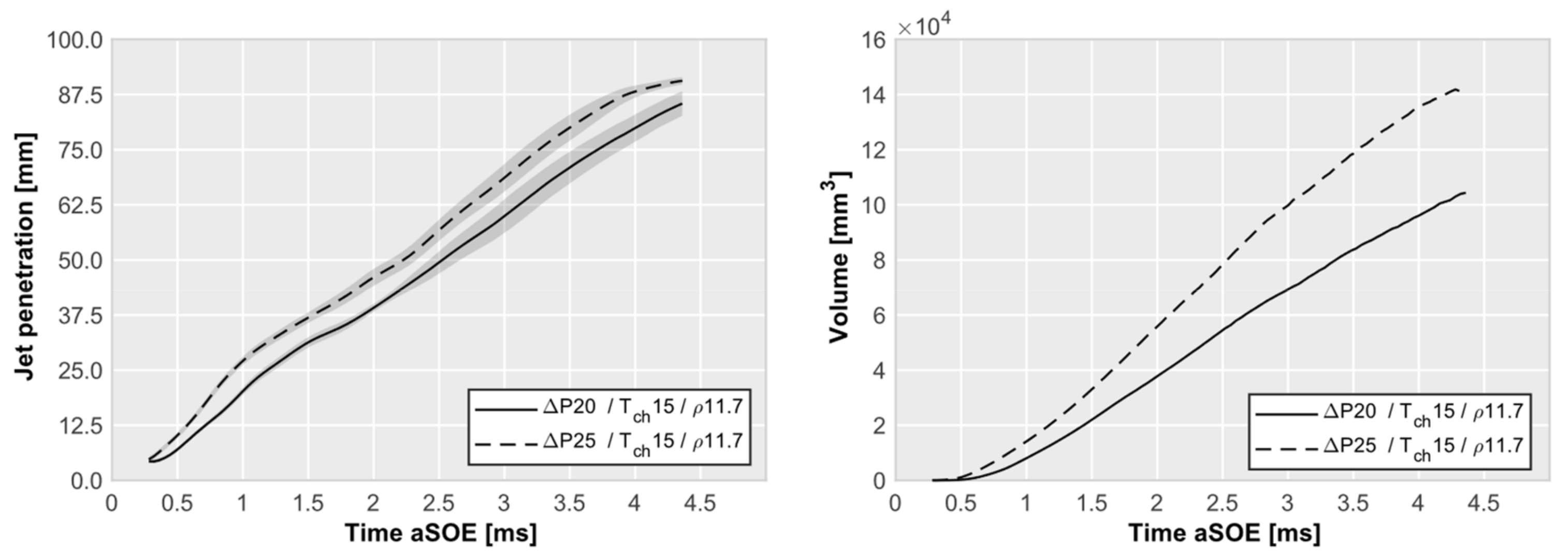
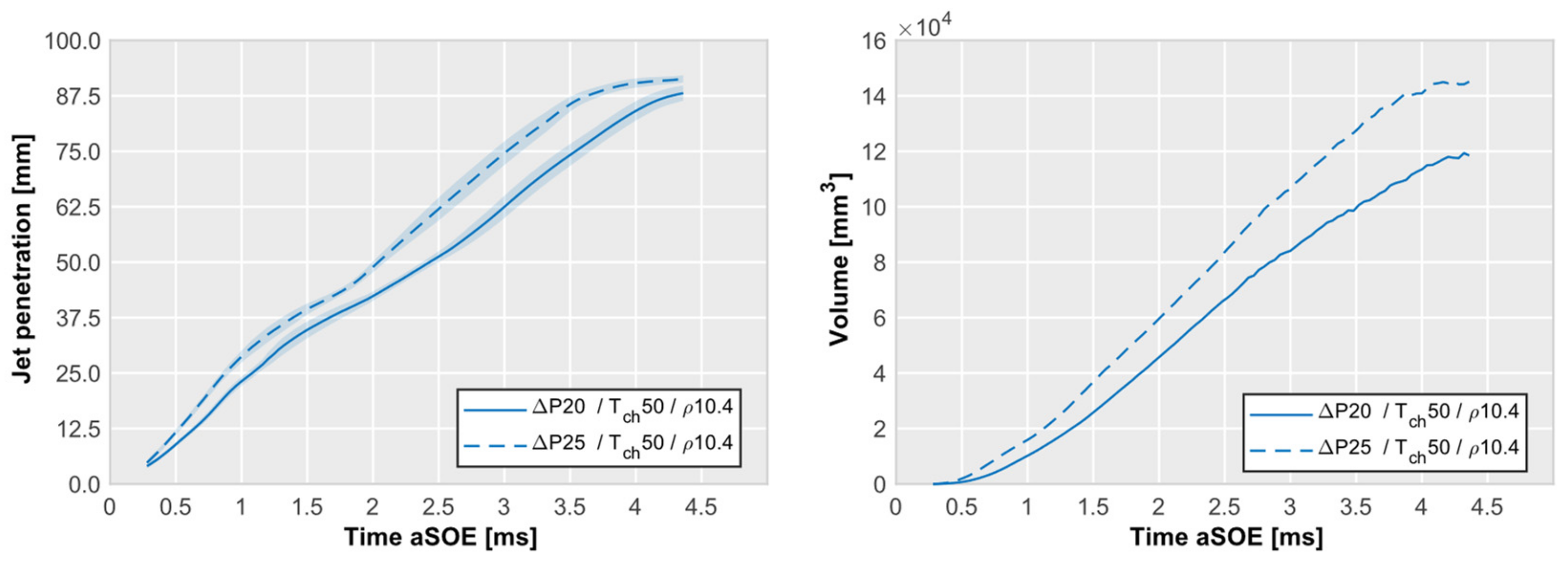
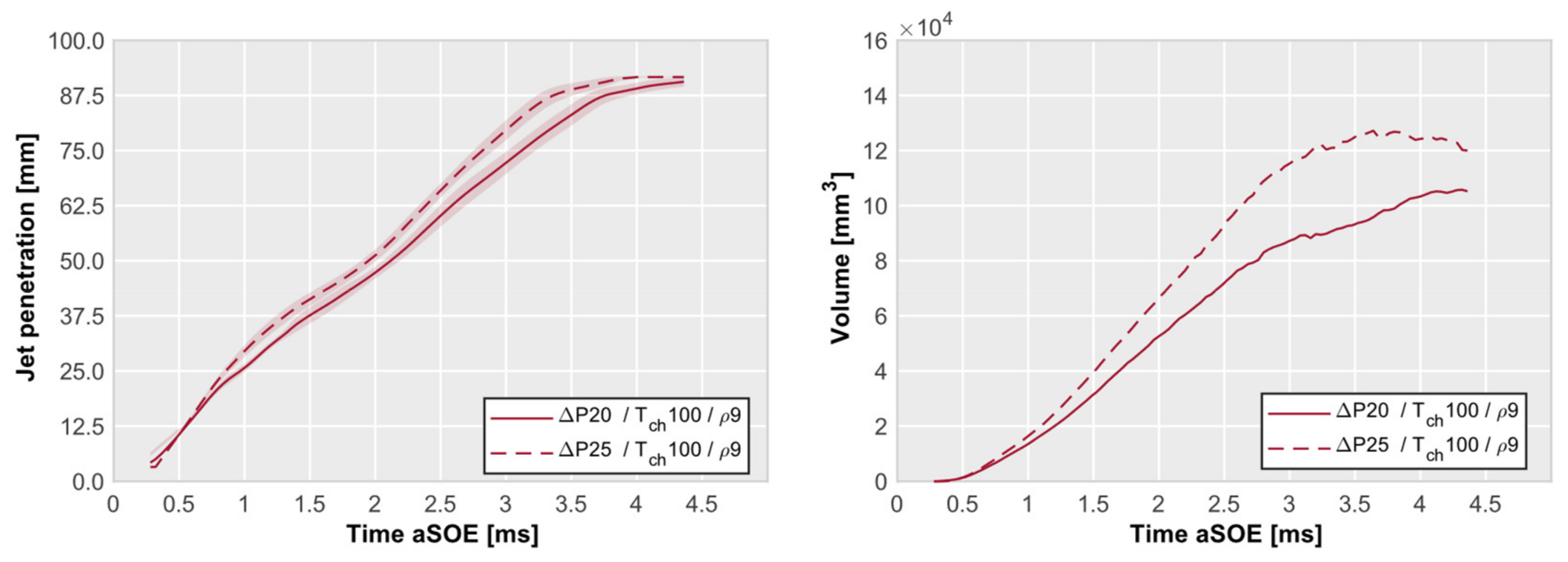
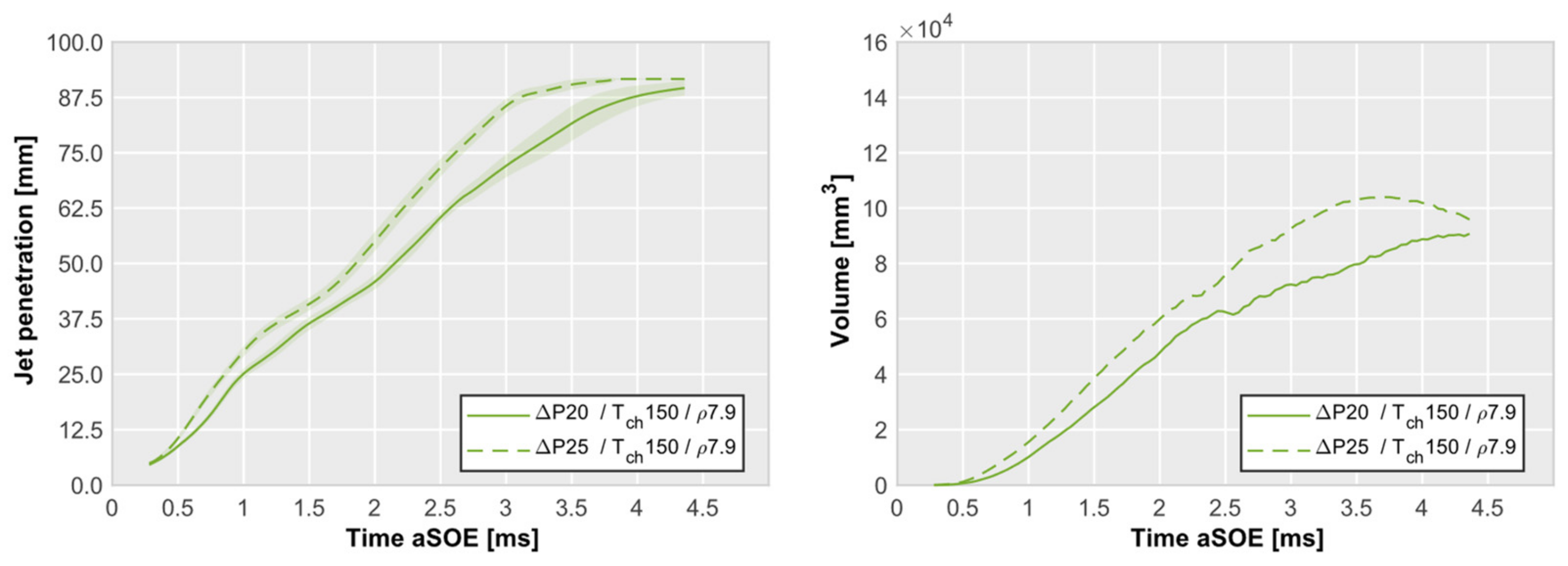
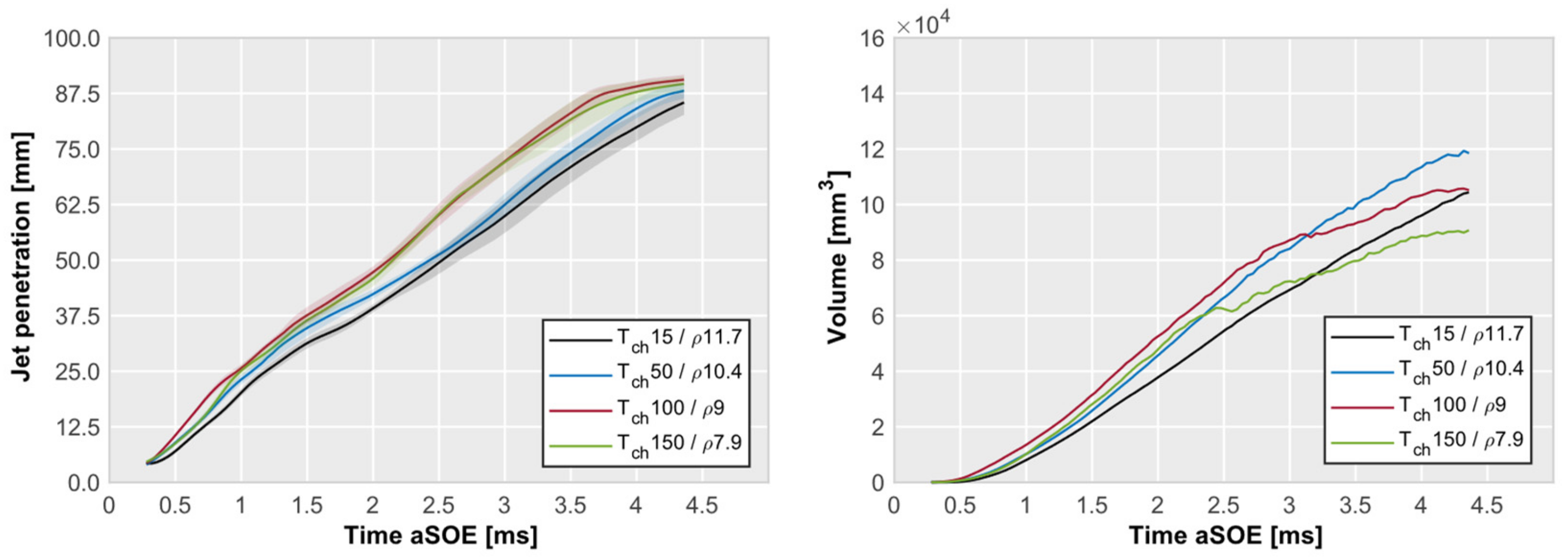
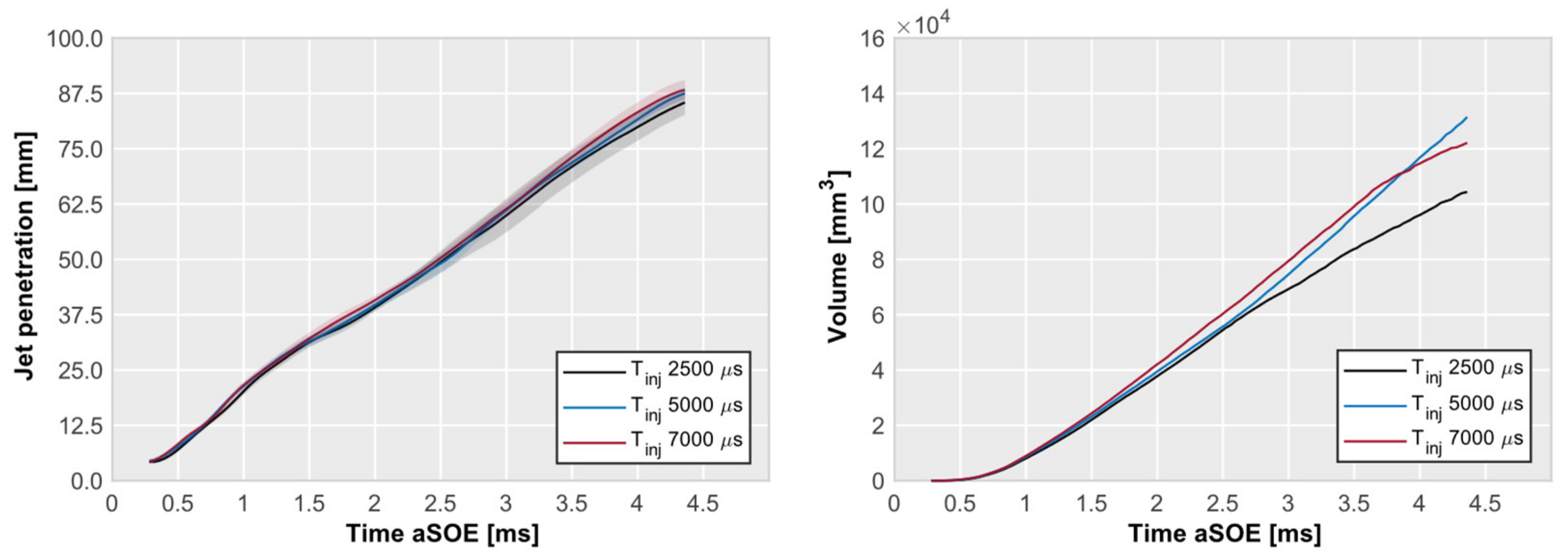

| Tch [°C] | Pinj [bar] | BP [bar] |
|---|---|---|
| 15 | 30 | 10 |
| 15 | 35 | 10 |
| 15 | 35 | 15 |
| 50 | 30 | 10 |
| 50 | 35 | 10 |
| 50 | 35 | 15 |
| 100 | 30 | 10 |
| 100 | 35 | 10 |
| 100 | 35 | 15 |
| 150 | 30 | 10 |
| 150 | 35 | 10 |
| 150 | 35 | 15 |
| Parameter | Value | Unit |
|---|---|---|
| Density | 0.089 a 71 b,c | kg/m3 |
| Stoichiometric air demand | 34.3 | kgair/kgfuel |
| Lower heating value | 120 | MJ/kgKst |
| Mixture Calorific value e | 3.2 4.53 | MJ/m3 |
| Boiling temperature c | −253 | °C |
| Ignition limits d | 4–76 0.2–10 | Vol-% λ |
| Minimum ignition energy c,d,e | 0.02 | mJ |
| Self-ignition temperature | 585 | °C |
| Diffusion coefficient a,d | 8.5 × 10−6 | m2/s |
| Quenching distance c,d,f | 0.64 | mm |
| Laminar flame speed d,e | 200 | cm/s |
| Carbon content | 0 | Mass-% |
| Parameter | Value |
|---|---|
| Camera | Photron SA-Z (Tokyo, Japan) |
| Lens diameter | 100 mm |
| Diaphragm gap diameter | 4 mm |
| Frame rate | 25 kfps |
| Shutter time | 2.5 µs |
| Frames per trigger | 300 |
| Repetitions | 10 |
| Px/mm ratio | 11.45 |
Disclaimer/Publisher’s Note: The statements, opinions and data contained in all publications are solely those of the individual author(s) and contributor(s) and not of MDPI and/or the editor(s). MDPI and/or the editor(s) disclaim responsibility for any injury to people or property resulting from any ideas, methods, instructions or products referred to in the content. |
© 2024 by the authors. Licensee MDPI, Basel, Switzerland. This article is an open access article distributed under the terms and conditions of the Creative Commons Attribution (CC BY) license (https://creativecommons.org/licenses/by/4.0/).
Share and Cite
Payri, R.; Novella, R.; Nasser, K.I.; Bori-Fabra, O. Spray Characterization of Direct Hydrogen Injection as a Green Fuel with Lower Emissions. Energies 2024, 17, 2405. https://doi.org/10.3390/en17102405
Payri R, Novella R, Nasser KI, Bori-Fabra O. Spray Characterization of Direct Hydrogen Injection as a Green Fuel with Lower Emissions. Energies. 2024; 17(10):2405. https://doi.org/10.3390/en17102405
Chicago/Turabian StylePayri, Raul, Ricardo Novella, Khodor I. Nasser, and Oscar Bori-Fabra. 2024. "Spray Characterization of Direct Hydrogen Injection as a Green Fuel with Lower Emissions" Energies 17, no. 10: 2405. https://doi.org/10.3390/en17102405
APA StylePayri, R., Novella, R., Nasser, K. I., & Bori-Fabra, O. (2024). Spray Characterization of Direct Hydrogen Injection as a Green Fuel with Lower Emissions. Energies, 17(10), 2405. https://doi.org/10.3390/en17102405






